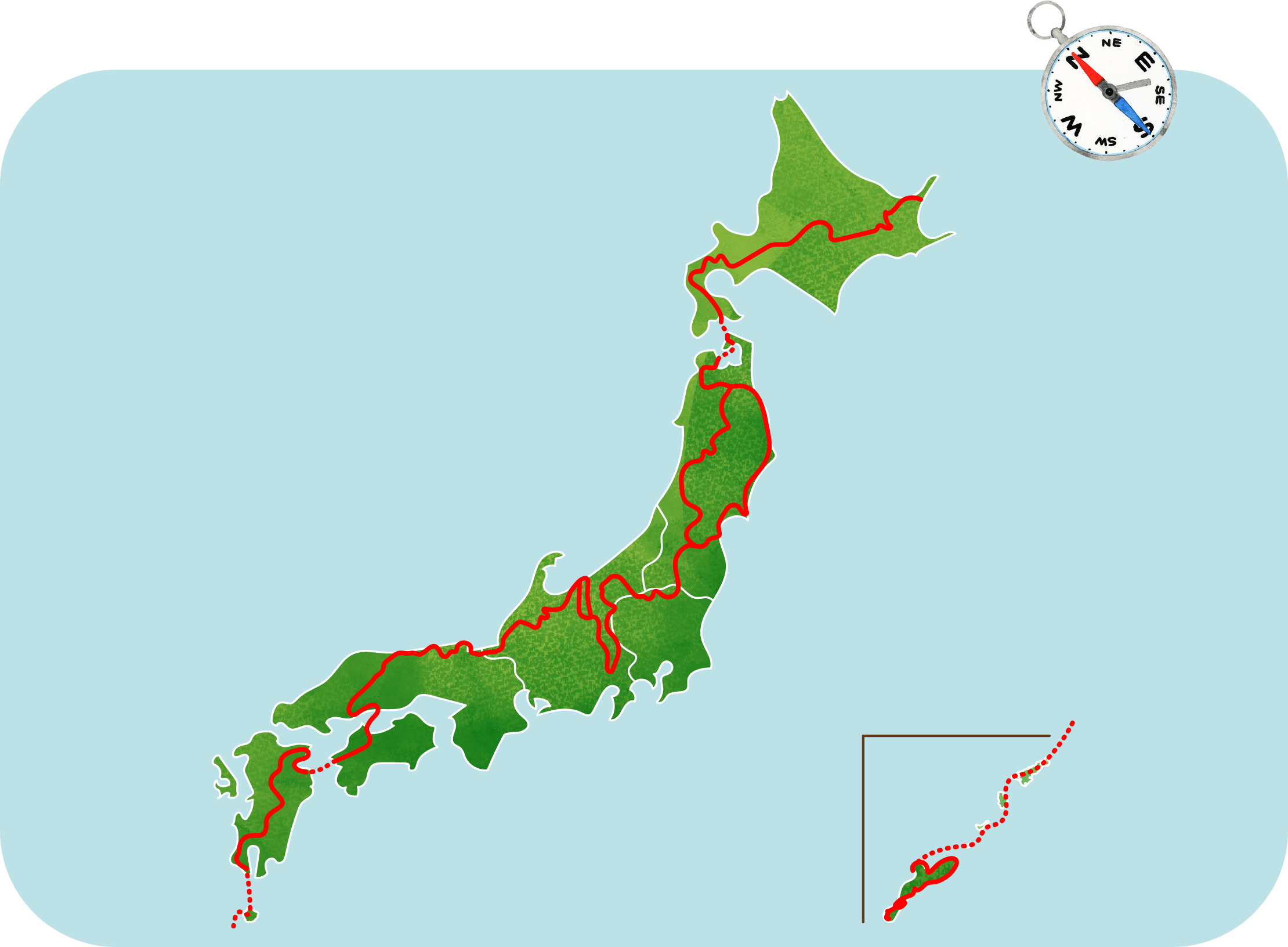

MISSION
HISTORY OF LONG-TRAIL WALKING IN JAPAN
The concept of long trail walking is becoming more popular now in Japan, but its roots go as far back as a thousand years ago: the famous ‘walking culture’ of the Shikoku, Oise and Kumano pilgrimages. The travelogs of the great haiku poet Matsuo Basho, such as Oku No Hosomichi (The Narrow Road to the Deep North), are still read today and serve as inspiration for travel. The Japanese have long valued seeking out and admiring beautiful flowers, plants and trees – so much so that there are dedicated words to describe activities such as hanami (cherry blossom viewing), momiji gari (autumn leaf viewing) and monomiyusan (sightseeing and playing in nature). Majestic mountains have also been the object of awe and have been worshiped as sacred.
The modern mountaineering era in Japan got its start in the 19th century and was heavily influenced by Western alpinism, and continued to flourish after the post-war mountaineering boom. In the last decade, the strict definition of mountaineering has expanded, attracting more and more people to moderate hikes that don’t need advanced techniques or specialist equipment. It’s becoming increasingly popular not only to climb to the top of mountains, but also to wander along long mountain paths, stroll through mountain villages, just enjoying the walk itself.
The Shinetsu Trail, which is considered to be the pioneer of long trails in Japan, opened in 2008, and several other long walking trails followed in its wake. Hikers from home and abroad have walked these trails, indulging in their desire to enjoy a healthy lifestyle that respects nature. These trail walkers have also contributed significantly to the revitalisation of regional economies. The Japan Long Trail Association, a non-profit organization, was established in 2015 to unite these trails so that hikers and other long trail enthusiasts can walk from one end of Japan to the other.
Now, as healthy lifestyles and a deep appreciation for nature continue to increase in popularity, especially after the Covid-19 pandemic, we are advocating for the creation of the JAPAN TRAIL. This will enable people to enjoy a better quality walking journey, and will give them the opportunity to walk a total distance of 10,000 km when the trail is complete. Furthermore, the JAPAN TRAIL will unite trails that connect the archipelago, finally allowing people to walk from one end of the country to the other. Our ambition and hope is to develop this trail into a symbol of Japan’s trail walking culture, to be loved – and used – by hikers well into the future. It will become part of a lasting walking heritage in Japan.
JAPAN TRAIL ADVOCACY
COMMITTEE MISSION
- In Japan, we will:
- ・Position the JAPAN TRAIL as a symbol of Japan’s trail culture, and advocate for long trails across the country.
- ・Redefine the traditional understanding of ‘hiking’, so that it can be enjoyed by more people in a wider range of ways.
- ・Highlight the enjoyment of rediscovering the charms of Japan through walking.
- ・Educate children and young people about the importance of experiencing nature through walking, learning about local history and culture first hand through experience and talking with local people.
- ・Revitalize local tourism by rediscovering the culture of the areas the trail passes through.
- ・Educate people about the importance of personal responsibility and safety when hiking.
- ・Communicate the mental and physical benefits of walking and communing with nature.
- ・Propose easy ways for developing a healthier lifestyle through walking and hiking, to help people recover from the Covid-19 pandemic.
- ・Provide detailed information and guidance for all visitors.
- ・Foster a deeper connection with the environment, and raise awareness of local conservation needs and ongoing efforts.
- ・Propose that trails are used for environmental education, especially for children and young people.

STEPS WE ARE TAKING TO SET UP THE JAPAN TRAIL

- ・We are choosing routes that are safe to walk throughout the four seasons whenever possible. However, some routes may become impassable for a certain period of time due to snow accumulation.
- ・We are using existing trails, hiking paths, nature trails, and walking paths, including trails that are members of the Japan Long Trails Association.
- ・We are using long-distance nature trails under the jurisdiction of the Ministry of the Environment, those operated by local governments, and old roads and highways steeped in history and culture.
- ・We are avoiding paved national and prefectural roads as much as possible.
- ・We will grade trails by section to meet international standards.
- ・We are using the Western definition of hiking, therefore all walking activities below rock, snow, and ice fields where alpinists are active will be considered suitable for hiking.




